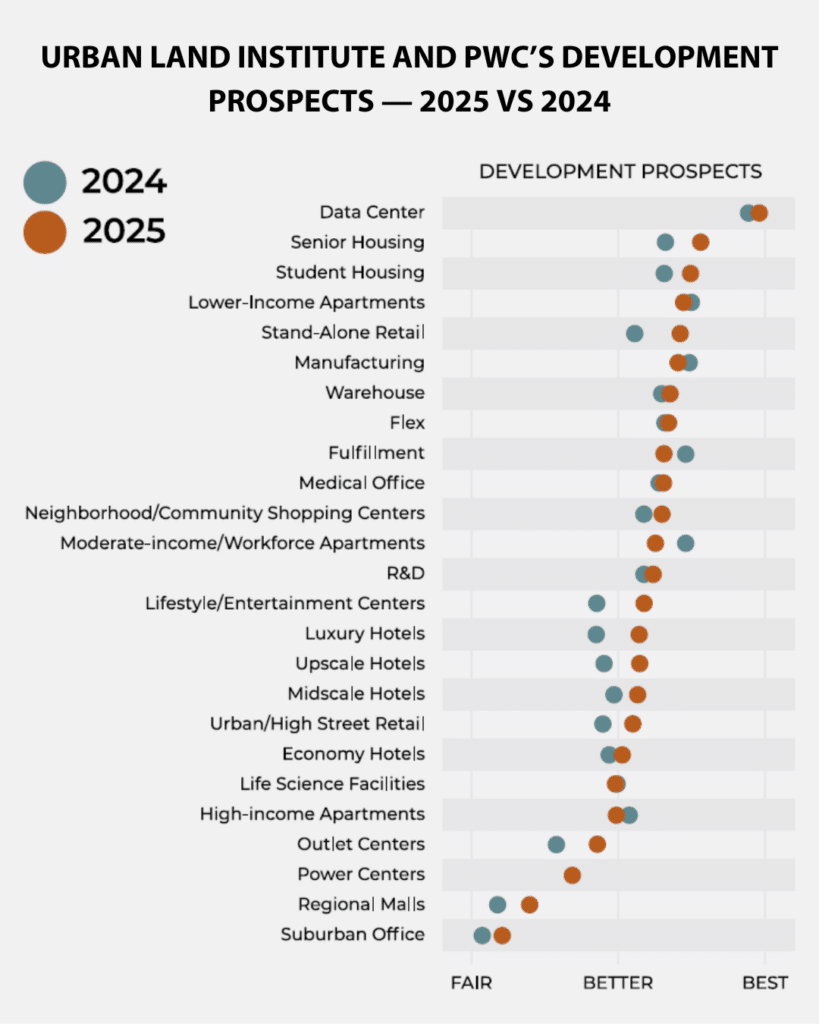
Most Promising Real Estate Development / Building Opportunities in 2025
2025 real estate development prospects
The real estate market is always evolving, and as we get into 2025, some sectors are poised for growth while others may be facing barriers. The latest outlook from the Urban Land Institute and PwC highlights key shifts in development prospects across commercial and multifamily real estate, offering investors and developers a glimpse into where might focus their attention. As usual, the report reveals the property types that are gaining traction and which may require a more strategic approach to help you make informed decisions this year.
Multifamily and senior housing development dominate
In 2025, senior and multifamily housing continue to dominate real estate development prospects, reflecting stable demand driven by demographic shifts and evolving lifestyle preferences.
Senior housing benefits from the aging baby boomer population, with developers racing to address a growing need for communities that combine health care, social connectivity, and modern amenities. Meanwhile, multifamily housing demand remains strong as rising home costs and evolving renter preferences drive interest in flexible, high-quality spaces.
Stand-alone retail and manufacturing follow closely behind, with retail projects increasingly focused on experiential, community-oriented spaces and manufacturing developments propelled by reshoring trends and the growth of high-tech industries like electric vehicle (EV) battery production. These sectors, though diverse, share common threads of adaptability, sustainability, and responsiveness to economic and social dynamics, ensuring they remain at the top of the prospects list for developers in 2025.
Data Centers: Keep watch in the Upper Midwest
Data centers are seeing a tremendous surge, fueled by the growing need for AI and cloud computing. Currently, the growth is primarily occurring in other parts of the U.S., with Ohio, Texas, and Virginia setting the pace. But that growth can continue only as long as the local energy supply can support it.
While those data centers have been multiplying elsewhere, the Upper Midwest has been quietly building the energy infrastructure needed to support data centers. Recently, significant movement has been made in sectors such as power and gas plants, particularly in solar and wind energy projects. This infrastructure could potentially support future data center developments just as other regions’ energy supplies tap out. That, plus the fact that state and local governments in Minnesota and Wisconsin are now offering tax incentives and grants to attract data center investments, makes this sector one to watch in the Upper Midwest.
Exceptions to every rule
Of course, no forecast is without its surprise exceptions. If you have a vision for a commercial property or a project in mind, we’re here to help. Our team of predevelopment, design, and construction professionals is ready to guide you through the complexities of 2025 and beyond, ensuring your project is not just built but built for success.
To learn more about design-build trends and opportunities, download a free copy of DBS Group’s 2025 Trend report.
